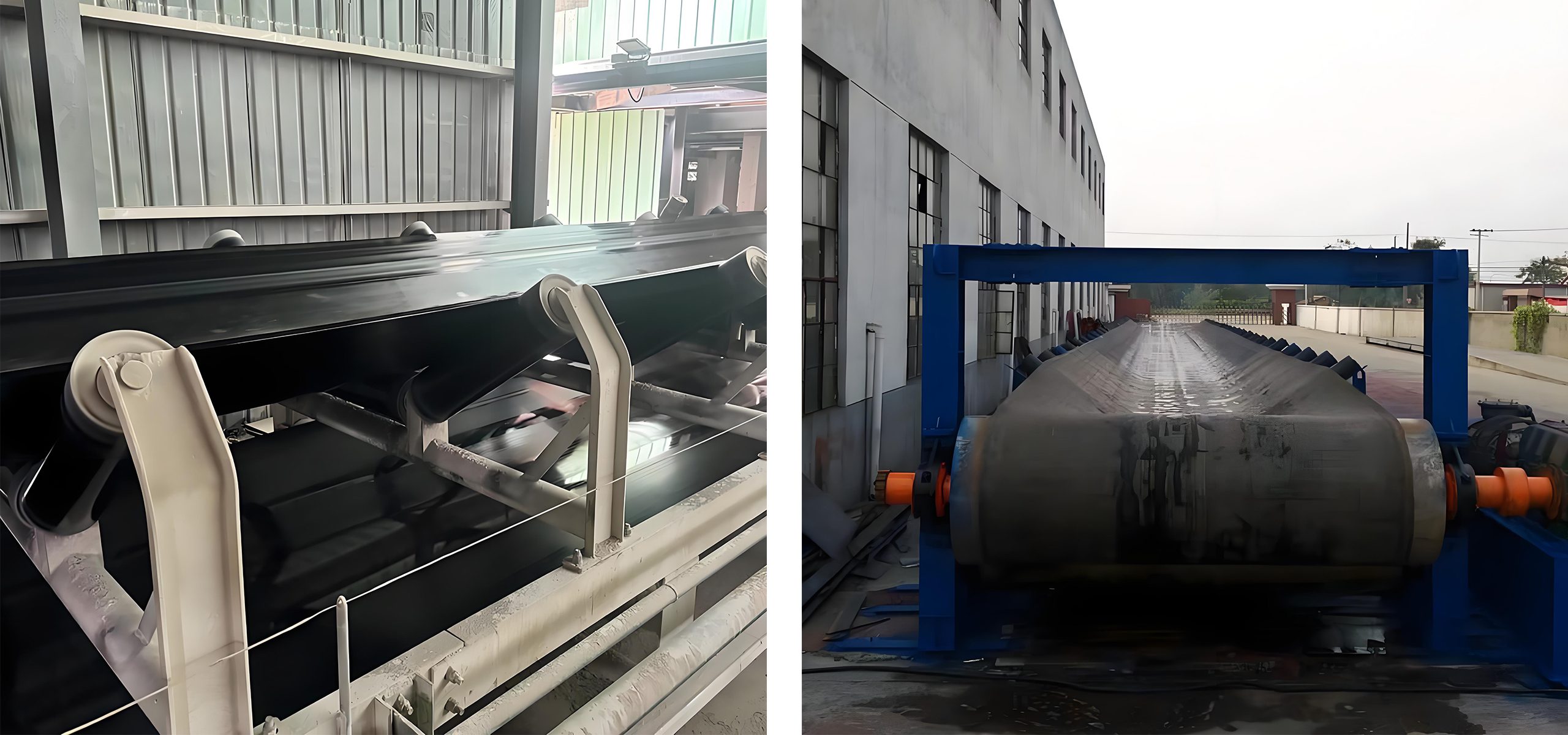Перекос ремня (Конвейерная лента проблема слеживания) - одна из самых частых и дорогостоящих проблем в системах транспортировки сыпучих материалов. Когда Ваша конвейерная лента сбивается с пути, это приводит к преждевременному износу, проливу материала и даже остановкам. В этом руководстве анализируются причины смещения ленты и приводятся действенные решения по выравниванию конвейерной ленты, используемые экспертами отрасли.
Как отрегулировать конвейерную ленту?
1. Проверьте слежение ремня (выравнивание)
Наблюдайте за движением ремня: Запустите конвейер и обратите внимание, не смещается ли лента в одну сторону.
Отрегулируйте опорные ролики/катки:
На хвостовом (загрузочном) конце: Ослабьте болты с одной стороны хвостового шкива и аккуратно отрегулируйте, чтобы направить ремень.
На головном (приводном) конце: В некоторых системах есть следящие винты - слегка поверните их, чтобы отрегулировать выравнивание ленты.
Используйте втулочные или натяжные ролики: Отрегулируйте угол наклона этих роликов, чтобы направить ленту обратно в центр.
Правило большого пальца: Отрегулируйте сторону, в которую движется ремень (например, если ремень смещается влево, отрегулируйте левую сторону немного вперед).
2. Отрегулируйте натяжение ремня
Проверьте Slack: Ремень не должен чрезмерно провисать, но и не должен быть чрезмерно натянут.
Методы натяжения:
Ручная регулировка винтов: Ослабьте болты на узле захвата и передвиньте шкив, чтобы увеличить/уменьшить натяжение.
Гравитационный захват: Отрегулируйте противовесы, если они есть.
Гидравлические/пневматические системы: Следуйте рекомендациям производителя по регулировке давления.
Тест на правильное натяжение: Ремень должен слегка прогибаться, но не проскальзывать под нагрузкой.
3. Осмотрите и выровняйте ролики
Убедитесь, что все ролики установлены:
Перпендикулярно направлению движения ленты.
Без мусора и повреждений.
Вращение плавное (замените заклинившие ролики).
4. Проверьте распределение нагрузки
Неравномерная загрузка может привести к смещению. Отцентрируйте материал на ленте.
5. Тестируйте и настраивайте
Запустите конвейер вхолостую, затем под нагрузкой, выполняя небольшие регулировки до тех пор, пока слежение не станет стабильным.
Советы по безопасности:
Перед регулировкой всегда отключайте питание и блокируйте конвейер.
Носите перчатки и избегайте мест защемления.
Если ремень продолжает смещаться, проверьте, нет ли изношенных краев, поврежденных шкивов или структурных проблем. Постоянные проблемы могут потребовать профессионального обслуживания.
Почему возникает несоосность конвейерных лент?
Основная проблема заключается в том. неравномерное растягивающее напряжение по ширине ленты или Боковая сила от роликов/барабанов. Вот 8 наиболее распространенных виновников:
1. Несоответствие центров головки и хвоста барабана
- Проблема: Если центры головного и хвостового барабанов не идеально выровнены при установке, продольная центральная линия ремня отклоняется.
- Исправьте: Используйте лазерные инструменты для выравнивания, чтобы обеспечить Допуск ≤3,0 мм (в соответствии со стандартами CEMA).
2. Неправильное позиционирование роликов
- Проблема: Ролики ведомых роликов не перпендикулярны к осевой линии ремня с усилием сдвиньте ремень в сторону.
- Исправьте: Проверьте Выравнивание роликовой рамы с помощью линейки и отрегулируйте перекос валиков.
3. Неправильное соединение ремней (механическое/вулканизированное)
- Проблема: A некачественное соединение ремня создает неравномерное распределение напряжения.
- Исправьте: Для вулканизированные соединенияОбеспечьте равномерность ширины 100%; для механических соединений используйте конические крепежи.
4. Ослабление или смещение рамы ролика
- Проблема: Ослабление болтов или деформация рамы смещает Осевая линия группы роликов.
- Исправьте: Затяните все болты и проверьте параллельность кадров Ежемесячно.
5. Неравномерное повреждение ремня
- Проблема: Если один край более изношен (Повреждение края ремня), возникает дисбаланс напряжения.
- Исправьте: Поверните реверсивные ремни или замените их, если растяжение превышает 2%.
6. Смещение центра загрузки (точка выгрузки материала)
- Проблема: Сила удара материала из перекошенных желобов толкает ленту вбок.
- Исправьте: Установи Самоцентрирующиеся загрузочные лотки или регулируемые плуги.
7. Скопление материала на валиках/барабанах
- Проблема: Скопление липкого материала неравномерно изменяет диаметр роликов.
- Исправьте: Используйте поломоечные щетки или ролики с керамическим покрытием.
8. Внезапный удар от тяжелых грузов
- Проблема: Падение крупных кусковых материалов Создайте мгновенную боковую силу.
- Исправьте: Добавить ударные кровати или амортизирующей резины в зонах нагрузки.
Проверенные решения для устранения несоосности ремней
Быстрые исправления для немедленных результатов
- Отрегулируйте направляющие ролики: Поверните тренировочный ведомый диск На 15° в сторону, где лента обгоняет.
- Чистые ролики: Удалить накопление материала с неметаллическими скребками.
Долгосрочные стратегии профилактики
- Установите автоматические системы слежения (например, PT Smart Track)
- Обновление до корончатых роликов для эффекта самоцентрирования
- Проведение лазерных проверок центровки ежеквартально
FAQ: Ответы на вопросы по отслеживанию конвейерных лент
В: Как я узнаю, что моя конвейерная лента смещена?
О: Ищите эти признаки:
- Ремень трется о раму (Повреждение края ремня)
- Проливание материала с одной стороны
- Неравномерный износ
Вопрос: Какова #1 причина смещения ремня?
О: По статистике, 40% случаев вызваны Неправильное выравнивание роликов (Отчет CEMA 2023).
В: Может ли поврежденный ремень вызвать смещение?
О: Да! Неравномерное натяжение ремня изменяет распределение напряжения - измеряйте толщину каждые 6 месяцев.
Основные выводы для операторов
- Всегда проверяйте Перпендикулярность ролика и выравнивание рамы во время технического обслуживания.
- Инвестируйте в Вулканизированное сращивание поверх механических соединений для длинных ремней.
- Монитор точки выгрузки материалов - Даже перекос в 5° может вызвать рассогласование.

В процессе эксплуатации ленточных конвейеров необходимо тщательно следить за смещением ленты. Своевременное выявление причин и принятие соответствующих мер - это ключ к поддержанию эффективной и стабильной работы. Следуя этим рекомендациям, Вы сможете эффективно снизить риски, связанные с несоосностью, и повысить эффективность производства.Для получения дальнейших запросов или помощи, пожалуйста, не стесняйтесь связаться с нами! Мы здесь, чтобы помочь и поддержать Вас.

